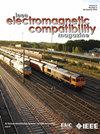一种改进的基于间断伽辽金法的微波击穿阈值预测方法
IF 2.5
3区 计算机科学
Q3 ENGINEERING, ELECTRICAL & ELECTRONIC
IEEE Transactions on Electromagnetic Compatibility
Pub Date : 2025-04-15
DOI:10.1109/TEMC.2025.3554044
引用次数: 0
摘要
微波器件容易受到大功率微波击穿效应的影响,严重影响其集成微波系统,包括电磁通信站和其他电子系统的可靠性。为了评估微波器件的高功率微波击穿特性,本文提出了一种改进的高功率微波击穿阈值预测方法。该方法通过调整扩散系数、附着率和压力等物理量,考虑了温度、气体和脉冲形状等更多操作因素的影响。此外,新修正的方程可以用不连续伽辽金方法有效地求解,这在处理复杂的多尺度结构方面已经证明了显著的优势。数值算例将阈值计算结果与商业软件计算结果进行了比较,验证了该方法的精度和效率。我们认为,该方法为预测各种条件下微波器件的击穿阈值提供了有效的工具,从理论上指导高性能微波元件保护机制的设计。本文章由计算机程序翻译,如有差异,请以英文原文为准。
A Modified Microwave Breakdown Threshold Prediction Method Based on Discontinuous Galerkin Approach
Microwave devices are susceptible to high-power microwave breakdown effect, which seriously impacts the reliability of their integrated microwave systems, including electromagnetic communication stations and other electronic systems. To evaluate the high-power microwave breakdown characteristics of microwave devices, this article proposes a modified method for predicting the high-power microwave breakdown threshold. The proposed method considers the influence of more operating factors such as temperature, gas, and pulse shape by adjusting physical quantities like diffusion coefficient, adhesion rate, and pressure. Additionally, the newly modified equation can be efficiently solved using the discontinuous Galerkin approach, which has been already proved significant advantages in handling complex multiscale structures. Numerical examples demonstrate the remarkable accuracy and efficiency of the proposed method by comparing the calculated threshold with results from commercial software. We believe that this method provides an effective tool for predicting the breakdown threshold of microwave devices under various conditions, theoretically guiding the design of protection mechanisms for high-performance microwave components.
求助全文
通过发布文献求助,成功后即可免费获取论文全文。
去求助
来源期刊
CiteScore
4.80
自引率
19.00%
发文量
235
审稿时长
2.3 months
期刊介绍:
IEEE Transactions on Electromagnetic Compatibility publishes original and significant contributions related to all disciplines of electromagnetic compatibility (EMC) and relevant methods to predict, assess and prevent electromagnetic interference (EMI) and increase device/product immunity. The scope of the publication includes, but is not limited to Electromagnetic Environments; Interference Control; EMC and EMI Modeling; High Power Electromagnetics; EMC Standards, Methods of EMC Measurements; Computational Electromagnetics and Signal and Power Integrity, as applied or directly related to Electromagnetic Compatibility problems; Transmission Lines; Electrostatic Discharge and Lightning Effects; EMC in Wireless and Optical Technologies; EMC in Printed Circuit Board and System Design.

 求助内容:
求助内容: 应助结果提醒方式:
应助结果提醒方式:


